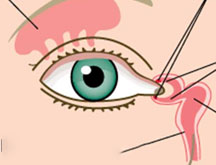
Dacryocystorhinostomy (DCR) is a surgical procedure performed to create a new drainage pathway for tears from the lacrimal sac into the nasal cavity. This procedure is typically done to treat nasolacrimal duct obstruction, a condition in which there is a blockage in the tear drainage system. Here are key points about dacryocystorhinostomy:
Indications:
- Dacryocystorhinostomy is indicated when there is a blockage or obstruction in the nasolacrimal duct, leading to symptoms such as excessive tearing, recurrent eye infections, and swelling near the tear sac (lacrimal sac).
Types of DCR:
- External DCR: Involves making a small incision on the skin near the side of the nose to access the lacrimal sac and create a new drainage opening.
- Endonasal DCR: A less invasive approach in which the procedure is performed through the nasal cavity, without an external incision.
Surgical Procedure:
- In both external and endonasal DCR, the surgeon creates a new connection between the lacrimal sac and the nasal cavity.
- A small piece of bone may be removed to create a bony ostium (opening) for tear drainage.
- The procedure may involve the placement of stents or tubes to maintain the drainage pathway during the initial healing period.
Anesthesia:
- DCR is typically performed under local or general anesthesia, depending on the patient's preference and the surgeon's recommendation.
Postoperative Care:
- After DCR, patients are often prescribed antibiotics and nasal decongestants to prevent infection and reduce nasal congestion.
- Stents or tubes, if used, may be removed during a follow-up appointment.
Recovery:
- Recovery time varies, but most patients experience improved tear drainage and relief from symptoms after the procedure.
- Patients are advised to avoid activities that may increase nasal pressure, such as blowing the nose forcefully.
Success Rate:
- Dacryocystorhinostomy has a high success rate in restoring normal tear drainage in individuals with nasolacrimal duct obstruction.
- The success of the procedure is influenced by factors such as the underlying cause of the obstruction and the surgeon's expertise.
Complications:
- Complications are rare but may include infection, scarring, or failure of the new drainage pathway.
- Close follow-up with the surgeon is important to monitor for any issues and ensure optimal healing.
Dacryocystorhinostomy is an effective surgical intervention for individuals experiencing symptoms related to nasolacrimal duct obstruction. The choice between external and endonasal DCR depends on factors such as the patient's anatomy, the underlying cause of the obstruction, and the surgeon's preference and expertise. If you or someone you know is considering dacryocystorhinostomy, it's important to consult with an experienced ophthalmic or otorhinolaryngology surgeon for a thorough evaluation and personalized recommendations.